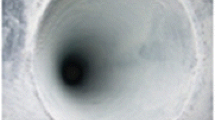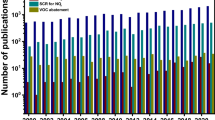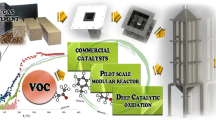Abstract
Bench-scale experiments have been conducted to evaluate a series of titania-supported Pt-Pd (as oxides) catalysts in the presence and absence of MoO3 and Fe2O3 additives for their effectiveness in the complete catalytic oxidation of volatile organic compounds (VOCs) in air likely to be found in waste gases. Under oxidizing conditions, all of the catalysts promoted the complete oxidation of VOCs to CO2 and H2O. 99 % Conversion was achieved with a C2H4-C2H6 gas mixture in air at temperatures between about 160–450 °C and at a space velocity of 20,000 h−1. Oxidation activity for the titania supported catalysts were found to decrease in the order Pt-Pd-Mo-Fe > Pt-Pd-Mo > Pt-Pd-Fe > Pt-Pd. However, the addition of MoO3 and Fe2O3 increase the catalyst activity and reduce the reaction temperature for the complete destruction. Ageing was also performed in order to study the stability of the most active catalyst. Pt-Pd-Mo-Fe (as oxides) on titania catalyst is effective in oxidizing a wide range of volatile organic compounds at relatively low temperatures (220–405 °C) and and at a space velocity of 40,000 h−1 and is resistant to poisoning by halogenated and amine volatile organic compounds.
Similar content being viewed by others
References
Larrinagan L.; Hall L.: Options for Controlling Organic Air Emissions. The National Environmental Journal pp 26 (May/June 1993)
Acres G.J.K.: Platinum Catalysts for the Control of Air Pollution. The Elimination of Organic Fume by Catalytic Combustion. Plat. Met. Rev. 14, 2 (1970)
Blazowski W.S.;Walsh D.E.: Catalytic Combustion: An Important Consideration for Future Application. Comb. Sci. Tech. 10, 233 (1975)
Windawi H.;Wyath M.: Catalytic Destruction of Halogenated Volatile Organic Compounds. Mechanisms of Platinum Catalyst Systems. Plat. Met. Rev. 37(4), 186 (1993)
Muller H.;Deller K.;Despeyrout B.;Peldszus E.;Kammerhofer P.;Kuhn W.;Spielmannleitnu R.;Stoger M.: Catalysis Today 17, 383 (1993)
Noordally E.;Richmond J.R.;Tahir S.F.: Destruction of Volatile Organic Compounds by Catalytic Oxidation. Catalysis Today 17, 359 (1993)
Agarwal S.K.;Spivey J.J.;Tevault D.E.: Kinetics of the Catalytic Destruction of Cyanogen Chloride. Appl. Catal. B: Environmental 5, 389 (1995)
Spivey J.J.: Complete Catalytic Oxidation of Volatile Organics. Ind. Eng. Chem. Res. 26, 2165 (1987)
Armor J.N.: Volatile Organic Compounds: An Overview. InEnvironmental Catalysis,Armor J.N. (ed.) 205th National Meeting of the American Chemical Society, Denover, Colorado, pp 298–300 (1993)
Sermon P.A.; Knight S.J.: Improvements in and Relating to Gas Purification Catalysts. British application GB 1558167-A (1975)
Summers J.C.;Frost A.C.: Catalytic Control of Gaseous Pollutants from Stationary Sources. The International Precious Metals Institute, Las Vegas, Nevada pp 1–12 (1991)
Author information
Authors and Affiliations
Rights and permissions
About this article
Cite this article
Tahir, S.F., Koh, C.A. Catalytic oxidation for air pollution control. Environ. Sci. & Pollut. Res. 3, 20–23 (1996). https://doi.org/10.1007/BF02986807
Received:
Accepted:
Issue Date:
DOI: https://doi.org/10.1007/BF02986807




